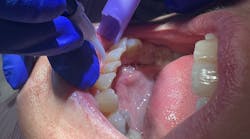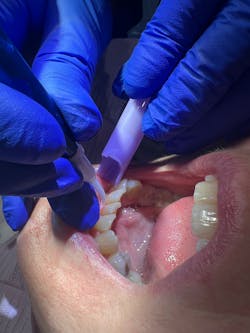Communicating with patients about dental lasers: Answering your patients' questions
Read more in this series on communicating with patients about lasers:
- Part one: What to say and how to say it
- Part two: What not to say
If we say things the correct way to our patients, what they hear will make sense to them and they’ll be more willing to move forward with their dental treatment plans. Lasers are a good example. In this series on communicating with patients about lasers, we’ve talked about some of the things we should say and how to say them, as well as some of the things we should not say. In this final article, we’ll look at what we should emphasize, how to answer patients’ questions about lasers, and, ultimately, how we can get an ROI for our laser treatment.
Emphasize these concepts with patients
- Periodontal therapy (PT): instead of “just a cleaning” or SRP or deep cleaning.
- Initial periodontal therapy (IPT): to explain patients getting started on periodontal therapy to activate their immune system.
- Infection: to make sure patients understand that infection doesn’t just stay in the mouth; it spreads through the entire body.
- Supportive periodontal therapy or periodontal maintenance: to describe treatment every three to four months for hygiene appointments.
Questions about laser treatment and sample answers
Here are some questions patients may ask you about dental laser treatment. Making use of role-playing and being prepared with your answers will help you feel more confident in helping patients understand what you’re saying.
Q: Will my insurance cover this?
A: Lasers are a new concept to insurance companies, and they don’t have a benefit for laser therapy. We incorporate laser therapy into existing codes to maximize your benefits. We will do our best to help you get the most from your insurance. Most insurance policies will assist with about 40% of the cost of dental laser therapy. However, we will let you know more about your individual benefits.
Q: Why is this different than my cleaning?
A: Laser periodontal therapy treats diseased necrotic tissue to heal more effectively. Prior to having laser technology, we had to depend on smoothing the root surface to help heal the tissue. With a laser, we can help you have a healthy root surface with healthy gum tissue, which will promote better healing and tissue attachment.
Q: Why do you have to do that pokey thing in my gums?
A: Periodontal evaluation (charting) is a closer look at the health of the gums and bone. By completing this evaluation, we have a road map to determine the extent of your infection. This also allows us to have a baseline for comparison in the future.
Q: Will the laser hurt?
A: Typically, the laser will reduce the need for anesthetic, but we want to make you as comfortable as possible. If anesthetic is needed, we can use topical or local anesthesia.
Q: What stage of gum disease do I have?
A: Following our evaluation, I will provide you with a treatment plan to consider.
Q: I have been coming here every six months and this has never been mentioned to me before.
A: As you know, technology continues to change. Dr. Smith and I want to provide the best possible care for you. In keeping with those standards, we need to make a greater effort in the early recognition and treatment of gum disease. What we now know and using laser technology, we can offer you the highest level of dental care.
Controlling the conversation
When the doctor arrives in the operatory, we get different responses from our patients. Sharing your findings with the doctor up front will help direct the conversation.
- RDH: Dr. Smith, today we have found significant periodontal infection in Mrs. Jones’ periodontal evaluation.
- Doctor: Mrs. Jones, Mindy has taken a lot of time collecting the necessary information for your periodontal evaluation. I agree with the need for laser periodontal therapy. Just as everyone heals differently from a cold, everyone will respond differently to laser treatment. We must remember that your condition did not occur overnight, so it may take a while for us to get everything under control.
Your laser is a tool—not a procedure
If you attach codes to your laser, you may have to write them off depending on your patient’s insurance. Some offices incorporate the laser into existing codes, so that patients don’t choose the procedures they want you to do. In other words, there’s no à la carte dentistry. If you use a laser code, typically it will be D4999. Just keep in mind that write-offs may occur.
Laser fees
These are some standard fees for dental laser treatment:
- Laser bacterial reduction (LBR) = $50 for full mouth
- Laser-assisted periodontal therapy (LAPT) = $100 per quadrant or per session
- Five days of hygiene per week = Eight patients per day (i.e., the hygienist works five days a week and sees eight patients)
If 50% of patients accept their treatment plans, we produce:
- 2 LBR x $50 = $100
- 2 LAPT x $100 = $200
- This would be an average increase of $300 per day.
- 5 days x $300 = $1,500 per week
- 4 weeks x $1,500 = $6,000 per month
- 12 months x $6,500 = $72,000 per year
If 80% of patients accept treatment plans, we produce:
- 2 LBR x $50 = $200
- 2 LAPT x $100 = $200
- This would be an average increase of $400 per day.
- 5 days x $400 = $2,000 per week
- 4 weeks x $2,000 = $8,000 per month
- 12 months x $8,000 = $96,000 per year
These fees can be changed or altered to increase revenue, but make sure you understand how the insurance process works and that write-offs will be based on the plans your office contracts with. Laser fees are typically not allowed to be charged to patients. Check the small print on each insurance policy to verify. It’s important to understand each patient’s insurance benefits and create standard verbiage your office can use.
The information in this series can help you create a protocol to help your patients understand what lasers can do in dentistry and how they can be beneficial to them and your dental team.
Author’s note: The Academy of Laser Dentistry is a good resource.
Read more about dental lasers …
So, you want to be a laser dental hygienist?
Which dental laser should I choose, and what can I use it for?
What type of training do dental hygienists need to use lasers?
What is the difference between LAPT and LBR?
Laser safety eyewear: It’s nonnegotiable
How do you find the best laser for your dental practice?
Laser procedures for dental hygienists: Herpetic lesions and desensitization
How dental hygienists can encourage greater use of lasers in the dental office
Editor’s note: This article first appeared in Through the Loupes newsletter, a publication of the Endeavor Business Media Dental Group. Read more articles and subscribe to Through the Loupes.








